Homemade Bacon
This post may contain affiliate links. See my disclosure policy.
Bacon is simply one of the most delicious foods on the planet and absolutely nothing beats homemade bacon! Learning how to make bacon is easy and you will be positively thrilled at the results!
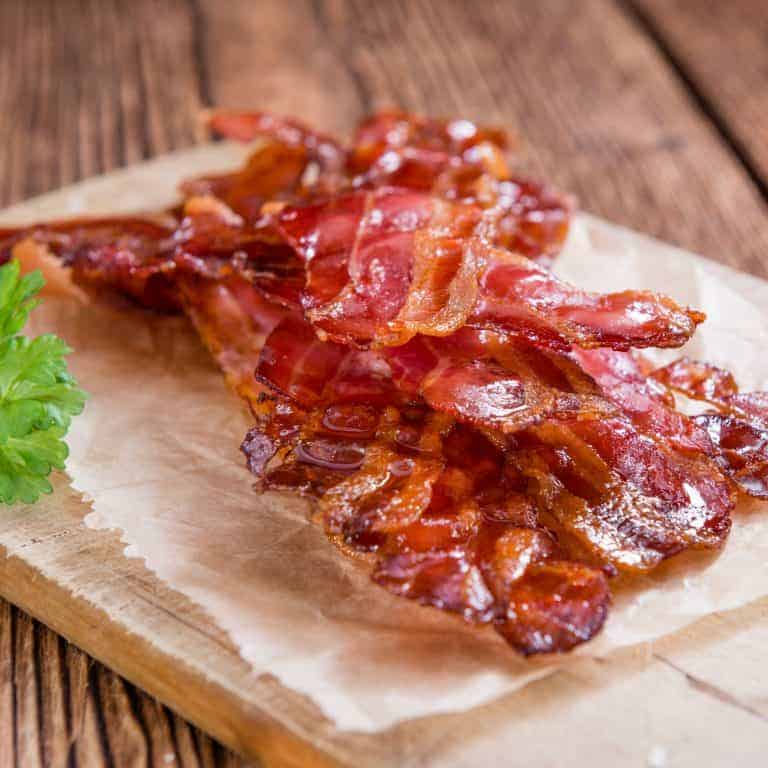
How to Make Bacon
Before we get to the tutorial on how to make homemade bacon, I have to unleash to poet within. Here it goes…
Ode to Bacon
How do I love thee? Let me count the ways.
I love thee to the depth and breadth and height
My soul can reach, when feeling out of sight
For the ends of being and ideal grace.
I love thee to the level of every day’s
Most quiet need, by sun and candle-light.
I love thee freely, as men strive for right…
…I love thee with the breath, smiles, tears, of all my life….
Okay, yes, Elizabeth Barrett Browning really wrote that poem for her husband, Robert. Not for a piece of cured pork. But really, can anyone prove that bacon wasn’t the object of her affection? Exactly. But whatever the catalyst of her emotions, one thing is indisputable: Bacon is sublime. And by that I mean the literal definition of the word: “Of such excellence, grandeur, or beauty as to inspire great admiration or awe.”
When it comes to bacon you just can’t beat homemade. You have full control over every element: The quality of the pork, the seasonings used, the curing method, the type of wood chips/smoke, the thickness of the slices. There’s no mystery when it comes to making bacon. It is simple and easy and even those minor efforts pay off BIG time!
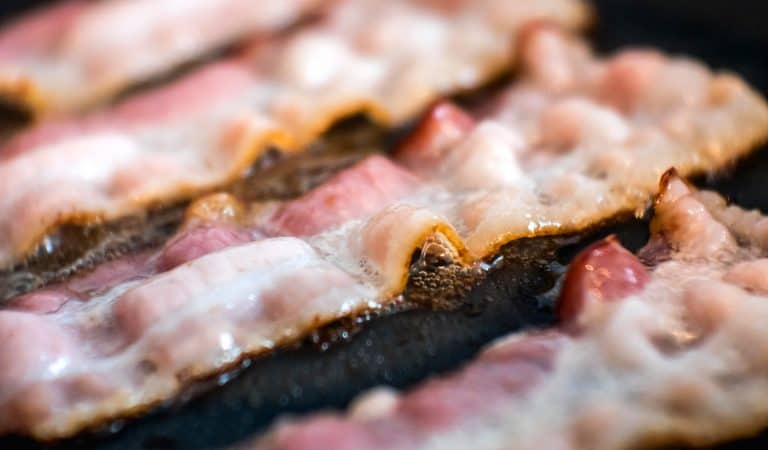
Before we get to how to make bacon, let’s address a couple of the most common questions: Should I dry cure or should I wet cure the bacon? And what about those nitrates/nitrites? Let’s start with the first question.
Should I Dry Cure or Wet Cure Homemade Bacon?
Some experts insist dry-curing results in a more pronounced flavor and that the bacon fries up more crispy than when using the wet-curing method. Other experts insist on the exact opposite. The battle rages on. The bottom line is that it comes down to personal interpretation and preference. I’ve used both methods, they both yield excellent results, but I tend to lean on the side of dry-curing. I’m including both methods for you to try. Pick one or the other or try them both and see which one you prefer. Now for the next question.
What About Those Nitrates/Nitrites?
Nitrates and nitrites get a bad rap and are commonly associated with processed deli meats, hot dogs and bacon. But they may be one of many examples of things that have been targeted and blown out of proportion by the media. As is typical of medical research, there are so many conflicting studies on this topic with directly opposing conclusions that it’s enough to make one’s head spin. Though the opponents to nitrates may argue, the fact is there is no definitive conclusion one way or the other.
What we do know is that not only have nitrates/nitrates been used for the last 12,000 years, nitrates/nitrites occur naturally in vegetables and in many cases in higher quantities than in cured meats. One source observes that “one serving of arugula, two servings of butter lettuce, and four servings of celery or beets all have more nitrite than 467 hot dogs.“
Another source notes, “those uncured hot dogs or bacon you’ve been conscientiously paying more for? Most are processed using celery or beet juice, whose nitrates turn into nitrites when they react with the saliva in your mouth [and] in many case…contain more nitrites than traditionally cured meats.” The claim to be made “without nitrates or nitrites” is a marketing ploy, and the use of celery or beet juice is the FDA loophole that allows them to make that erroneous claim.
(On an important side note, all the sources I’ve read emphasize strongly the importance of using the right quantities of nitrates and nitrites. Nitrates/nitrites can be toxic if the recommended quantities aren’t observed, so be sure to use exact measurements and correct ratio of curing salt to pounds of meat.)
Now I would never make the claim that bacon is healthy. Nor would I say that it’s perfectly safe to eat an unlimited amount of nitrates and nitrites. But I do personally maintain that a balanced diet that includes “all things in moderation” is a sound and a safe one.
So the question becomes less one of should I use nitrates/nitrites, and instead is one of why should I use them? And the answer to that is the same one that people made 12,000 years ago when they found that meat remained safe to eat when they used it.
Bacon is smoked low and slow within a temperature zone that bacteria can grow and multiply. The use of nitrites in bacon fights harmful bacteria and it also helps preserve the meat’s color. (Imagine grayish-brown bacon or hot dogs…now you know why those manufacturers of “nitrate/nitrite-free” meats still sneak them in, just under a different name.) So nitrates and nitrates help ensure both the safety of the meat as well as its pleasing aesthetics. And the flavor and aesthetics of bacon are very pleasing indeed!
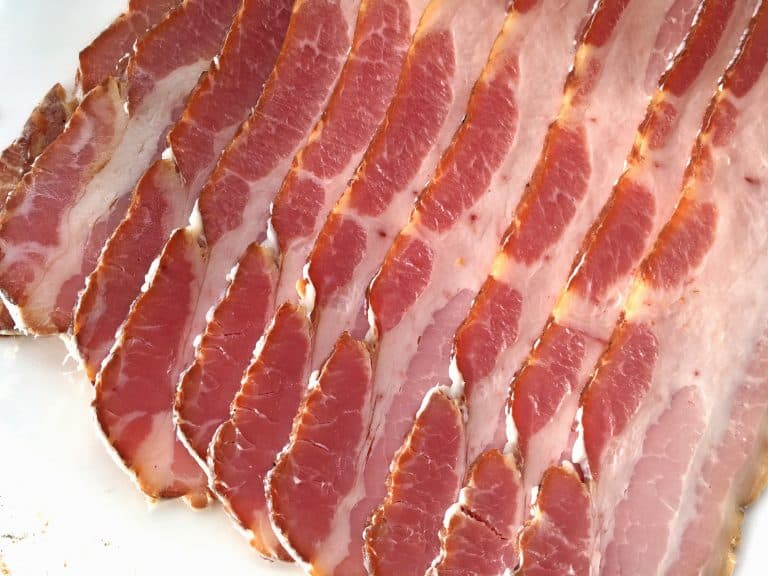
But let’s stop the talkin’ and let’s start smokin’!
Ladies and gents, it’s time to make some homemade bacon!
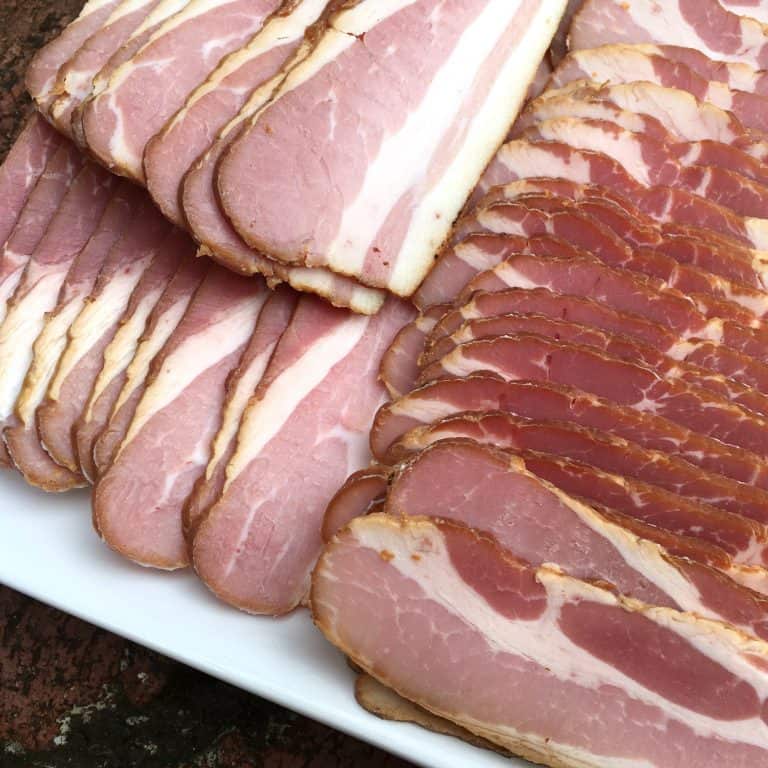
Homemade Bacon Recipe
As promised, I’m giving you both options for DIY bacon to choose from.
Better yet, try both and see which one you prefer.
Wet Cure Method
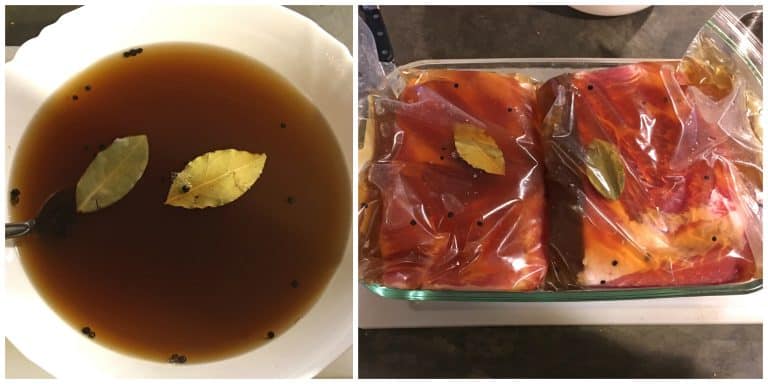
Add all the cure ingredients together in a large bowl and stir. Place the pork belly in gallon ziplock bag or container that just fits the size of the pork belly and pour the brine over it. If using a ziplock bag, place the bag in a container in case there is any leakage. Place it in the refrigerator for 7 days, flipping the bag over (or the pork belly itself if curing it in a container) every 2 days to ensure both sides of the pork belly are equally cured.
**A one-gallon bag will hold a 3-pound pork belly. If you’re following the recipe to use a 5 pound pork belly and plan on using the wet cure method with ziplock bags you can cut the pork belly in half and divide the brine equally between the two bags.
After 7 days the pork belly will have firmed up. Remove the pork belly from the brine, thoroughly rinse it off, and pat dry with paper towels. Some people say you should let the slab of bacon air dry for up to 24 hours before you smoke it. But many experts agree there is no need to do this. These experts argue that in leaving it wet the smoke actually sticks to the bacon better than if it’s dry.
At this point if you like you can rub it down with some cracked peppercorns and, if you want it sweeter, some brown sugar, honey or maple syrup.
Dry Cure Method
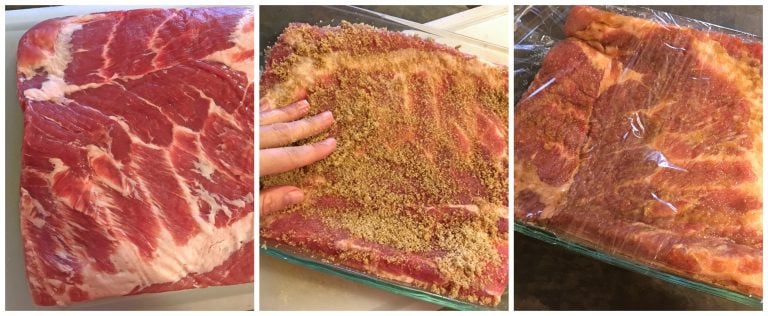
Place all the dry cure ingredients in bowl and stir to thoroughly combine them. It is essential that the pink curing salt is evenly distributed across the whole pork belly. So I like to give the rub a quick buzz through a spice/coffee grinder or you can use a small blender or a mortar and pestle.
Thoroughly and evenly rub down all sides of the pork belly with the dry rub. Place it in a ziplock bag or container (I’m using a casserole dish), with the fatty layer side down, and cover it with plastic wrap. Refrigerate it for 5 days. Flip the bacon over, redistribute the liquid that will have formed (if it’s in a ziplock bag simply turn the bag over and give it a good massage), and refrigerate for another 5 days.
After 10 days the pork belly will have become quite firm and stiff. Remove it from the the container or bag , rinse thoroughly, pat dry with paper towels, and proceed to smoking.
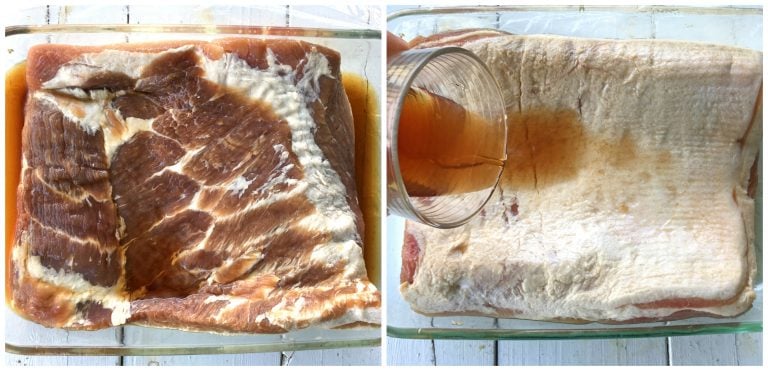
How to Smoke Homemade Bacon
Whether you’re using the wet or the dry curing method, the next step for smoking the bacon is the same.
As already mentioned, it’s also at this point that you can also sprinkle some coarsely ground pepper (if using) onto your wet-brined pork belly and “top off” the pepper on your dry-cured pork belly. You can also sprinkle on some extra brown sugar, maple syrup or honey.
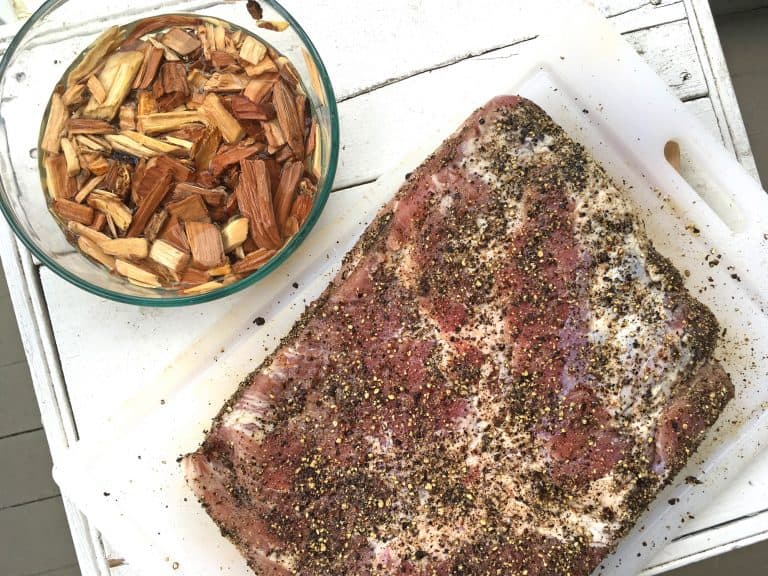
Preheat your smoker to 175-180 degrees F (do not exceed 200 F). I’ve used the Masterbuilt Digital Smoker the past 3 years. I love and highly recommend it. You can buy it online buy it online HERE. You can check out my full review HERE. Smoke the bacon for 3+ hours or until the internal temperature of the bacon reaches 150 degrees F. Add a handful of wood chips a couple of times during the smoking process.
If you’re using a grill, set up it up for 2-zone cooking and smoke the bacon fat side up (as the fat renders it will run down the meat) over indirect heat at 175-180 degrees F (don’t exceed 200 F) for about 3 hours or until the internal temperature of the bacon reaches 150 degrees F. Add a handful of wood chips a couple of times during the smoking process.
You’ll need an instant read thermometer. I absolutely love and recommend my Thermapen. For a cheaper alternative I have also used and recommend this one.
What kind of wood chips to use?
This comes down to personal preference. Hickory is the tried and true gold standard but cherry and apple are also excellent.
Once the bacon reaches an internal temperature of 150 degrees F, transfer the bacon to a plate and immediately place it in the fridge to cool down.
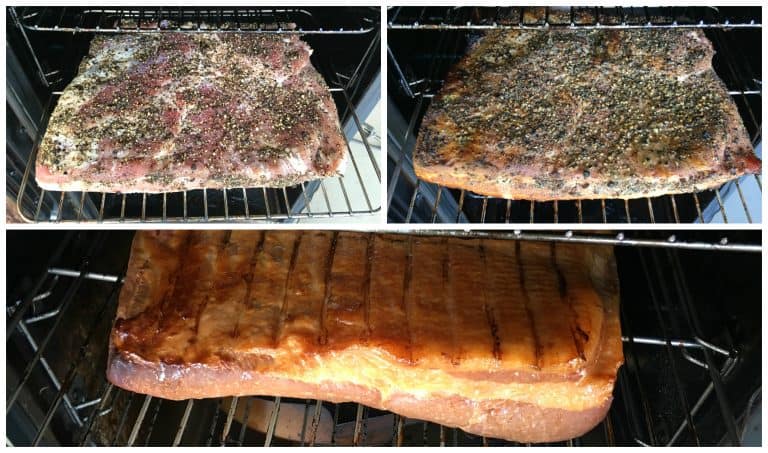
Slicing and Storing the Bacon
All you really need is a good sharp knife. But if you want those perfectly uniform, professional slices of bacon, you’ll need a meat slicer. Whichever you use, always slice across the grain.
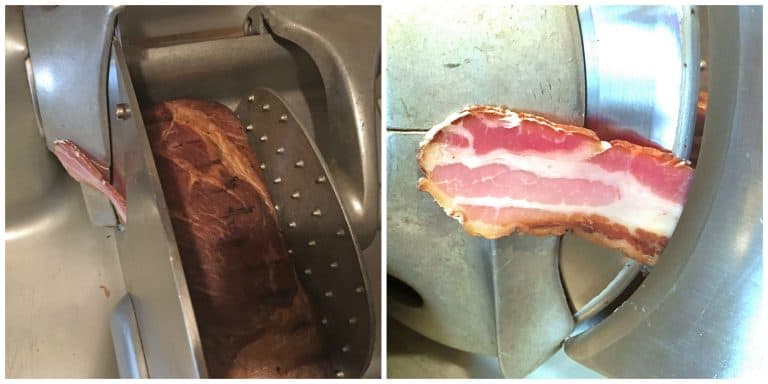
We found our 1970’s commercial Hobart slicer ten years ago on Craigslist. It has some imperfections to be sure, but it was a steal of a deal. For a meat slicer that won’t break the budget and that has excellent reviews, check out the Chef’s Choice Electric Meat Slicer.
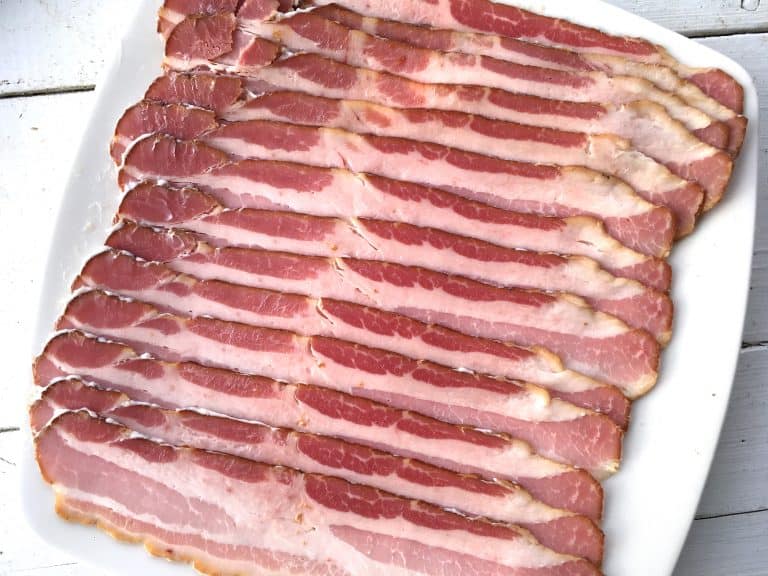
If you plan on using the bacon within 2 weeks, wrap it in several layers of plastic wrap followed by an outer layer of foil and keep it refrigerated. If you’re not going to use it within 2 weeks you can freeze it for up to 3 months.
To Freeze the Bacon: You can either use a vacuum sealer like Food Saver that will ensure its freshness, or you can do what I do (because my bacon never lasts beyond a couple of months anyway before it’s gobbled up): Lay the slices out on wax paper in the same fashion as store-bought bacon and place another sheet of wax paper over it. Fold the sides around the bacon. Place the wrapped bacon in a ziplock bag. I usually freeze the bacon in small amounts, the amount I know I usually need for one use. If you prefer the pieces not to stick together you can cut strips of was paper and place them between each slice of bacon.
When you’re ready to use it, simply remove the bacon from the freezer and let it thaw.
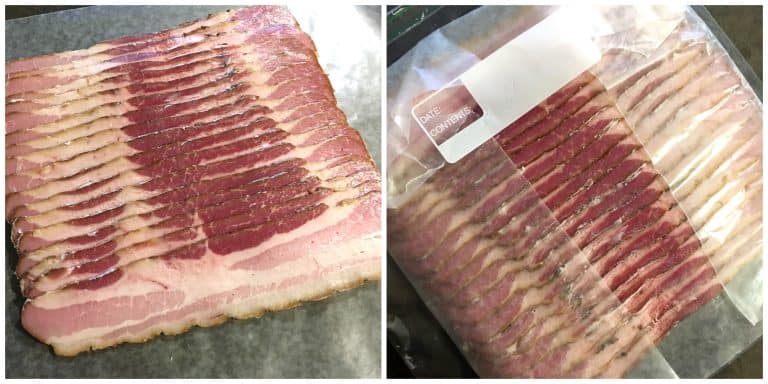
With your homemade bacon ready to go, now it’s time to EAT IT!
Enjoy!
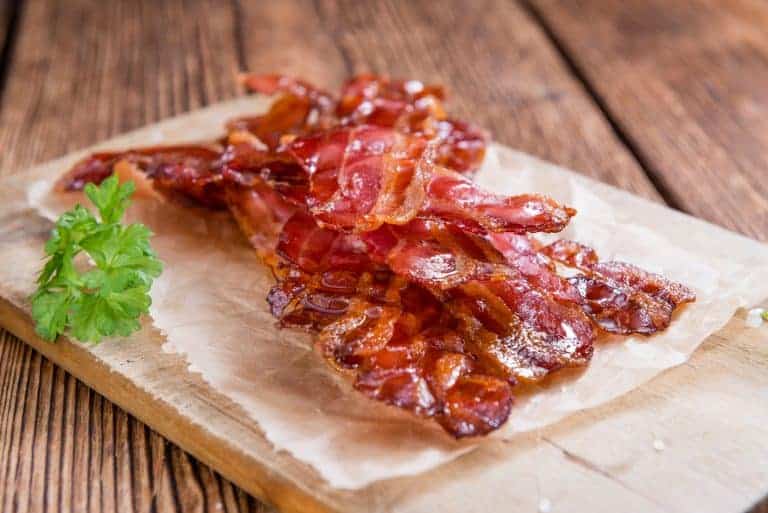
Be sure to also try my recipes for:
Save This Recipe
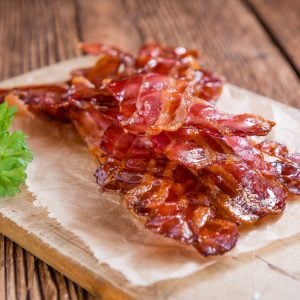
Homemade Bacon
Equipment
- Instant read thermometer (I love and recommend my Thermapen)
Ingredients
- For the Wet Cure Method:
- 5 pounds pork belly , skin removed
- 6 cups cool water
- 1/2 cup kosher salt
- 1/2 cup packed dark brown sugar (optional, if you want a sweet bacon)
- 2 teaspoons Prague powder #1 (measure carefully)
- 2 bay leaves
- 1 teaspoon whole black peppercorns
- For the Dry Cure Method:
- 5 pounds pork belly , skin removed
- 1/4 cup kosher salt
- 1/4 cup packed dark brown sugar (optional, if you want a sweet bacon)
- 1 teaspoon Prague powder #1 (measure carefully)
- Coarsely crushed black peppercorns (optional and amount according to personal preference)
Instructions
- **REFER TO BLOG POST FOR A COMPREHENSIVE TUTORIAL AND STEP-BY-STEP PROCESS****You can vary the flavors according to your preferences (see Recipe Notes) but do not adjust the salt or Prague powder amounts**
- For the Wet Cure Method:Add all the cure ingredients together in a large bowl and stir. Place the pork belly in gallon ziplock bag or container that just fits the size of the pork belly and pour the brine over it. If using a ziplock bag, place the bag in a container in case there is any leakage. Place it in the refrigerator for 7 days, flipping the bag over (or the pork belly itself if curing it in a container) every 2 days to ensure both sides of the pork belly are equally cured.**A one-gallon bag will hold a 3-pound pork belly. If you’re following the recipe to use a 5 pound pork belly and plan on using the wet cure method with ziplock bags you can cut the pork belly in half and divide the brine equally between the two bags.
- After 7 days the pork belly will have firmed up. Remove the pork belly from the brine and thoroughly rinse it off. Some people say you should let the slab of bacon air dry for up to 24 hours before you smoke it. But many experts agree there is no need to do this. These experts argue that in leaving it wet the smoke actually sticks to the bacon better than if it's dry. At this point if you like you can rub it down with some cracked peppercorns and, if you want it sweeter, some brown sugar, honey or maple syrup. Proceed to smoking (see below).
- For the Dry Cure Method:Place all the dry cure ingredients in bowl and stir to thoroughly combine them. It is essential that the pink curing salt is evenly distributed across the whole pork belly. We recommend using a spice/coffee grinder, a small blender or a mortar and pestle. Thoroughly and evenly rub down all sides of the pork belly with the dry rub. Place it in a ziplock bag or container (like a casserole dish), with the fatty layer side down, and cover it with plastic wrap. Refrigerate it for 5 days. Flip the bacon over, redistribute the liquid that will have formed (if it's in a ziplock bag simply turn the bag over and give it a massage), and refrigerate for another 5 days. After 10 days the pork belly will have become quite firm and stiff. Remove it from the the container or bag, rinse thoroughly, and pat dry with paper towels. At this point if you like you can rub it down with some cracked peppercorns and, if you want it sweeter, some brown sugar, honey or maple syrup. Proceed to smoking.
- To Smoke the Bacon:Preheat your smoker to 175-180 degrees F (do not exceed 200 F). (We use and love the Masterbuilt Digital Smoker). Smoke the bacon fat side up (as the fat renders it will run down over the meat) for 3+ hours or until the internal temperature of the bacon reaches 150 degrees F. (We use and recommend this instant read thermometer.) Add a handful of wood chips a couple of times during the smoking process. (Good options include hickory, apple or cherry.)If you're using a grill, set up it up for 2-zone cooking and smoke the bacon over indirect heat at 175-180 degrees F (don't exceed 200 F) for about 3 hours or until the internal temperature of the bacon reaches 150 degrees F.Once the bacon reaches an internal temperature of 150 degrees F, transfer the bacon to a plate and immediately place it in the fridge to cool down.
- To slice the bacon, slice it across the grain. You can use a large sharp knife or, for perfectly uniform/professional slices use a meat slicer.
- To store the bacon: If you plan on using the bacon within 2 weeks, wrap it in several layers of plastic wrap followed by an outer layer of foil and keep it refrigerated. If you’re not going to use it within 2 weeks you can freeze it for up to 3 months. To freeze the bacon: You can either use a vacuum sealer like Food Saver or you can lay the slices out on wax paper in the same fashion as store-bought bacon and place another sheet of wax paper over it. Fold the sides around the bacon. Place the wrapped bacon in a ziplock bag. If you prefer the pieces not to stick together you can cut strips of was paper and place them between each slice of bacon. When you’re ready to use it, simply remove the bacon from the freezer and let it thaw.
Notes
Nutrition
Originally published on The Daring Gourmet April 1, 2019



















Hi Kimberly. I just set a 2 lbs. slab in the fridge. I did one thing different and would like your opinion please. I didn’t have a big enough ziplock bag so I vac sealed it up (dry rub methid) with my food saver…thought?
Hi Neil, yes absolutely, vac sealing works great for the dry rub method!
I can not believe I spent so much time and money on this recipe. I followed it explicitly and the result is WAY TOO SALTY!! I gotta throw it away because I’m scared to eat it. I’m beyond pissed off!
Mark, I’m sorry your bacon was too salty but that’s not the fault of the recipe. Whether you’re using the dry or wet cure method, the instructions explicitly state to “thoroughly rinse” the pork belly after the curing phase.
Does this bacon have the traditional store bought bacon taste? we’ve been processing our own hogs for many many years and can’t seem to get that traditional bacon flavor.
Hi Felicia, I would say yes, but this has even more flavor. In my opinion some of the store-bought brands tend to be a little weak on the flavor.
I am trying to figure out about pink salt amounts. What is the window of too much or too little? What would go wrong either way? I had just over 3lbs belly and used about 3/4 pink salt. Thank you
So you recommend adding additional flavors/spices during the dry curing time, could it also be added after? Once rinsed, before drying/smoking?
Hi Thomas, yes, you can wait until it’s time to smoke it, but adding any flavors/spices to the brine or dry rub during the curing time will help ensure that those flavors have time to penetrate the bacon.
Hello Kimberly, this will be my third time making this recipe. I did wet cure then dry, I prefer the dry! Great recipe! Thank you!
Terrific, Angela, thank you so much for the feedback!
I don’t have a smoker. Can I cook this in the oven instead?
Hi Bev, bacon is smoked and if you cook it in the oven instead of smoking it with wood chips, it won’t taste like bacon, it will just taste like cooked pork belly.
I live in rural America, population 220, 4000 ft elevation, cattle country, bacon country, this is a fabulous recipe, I did add some crushed juniper berries, nothing else, Make 20 lbs at a time family and friends love it!!
Fantastic, Jay, I’m so thrilled to hear that! The crushed juniper berries are a nice touch. Thank you so much for the feedback!
I have a question about scaling for the salt and Prague Powder #1. Your recipe is for a 5 pound pork belly. I often find them at the store either cut in half or whole where they are significantly less or more than 5 lbs and the larger are not evenly divisible by 5 lbs. My question is, is there a formula you use to adjust the amount of salt and Prague powder for the weight of the belly? I would like to try the dry cure method. I have used the wet cure method many times, but I use a reliable online wet cure calculator to tell me how much of each to use based on the weight and thickness of the belly. I currently have a 3 1/2 lb pork belly in my freezer that I’d like to try this recipe on. Should I just convert your measurements to grams and adjust the amounts based on percentage of weight of the pork belly? Just want to make sure there’s not more to it than that. Thanks!
Hi Scott, yes, I would convert it to grams and adjust it to the weight of the pork belly. A teaspoon of Prague Powder #1 is about 5 grams (this can vary a little depending on the brand, but 5 grams is a safe bet).
Excellent recipe. I have been making my own bacon for a few months and have a question. I normally get good lean pork belly, bacon comes out great tasting but is always on the tough/chewy. Side any ideas.
Thank you, Roy! Temperature can play a big role in that, both the temperature of the smoker (you don’t want it too low) and the internal temperature of the bacon (you don’t want it too high). Also, this may be an obvious question, but are you making sure that you’re slicing the bacon across the grain? Another thing you can try is to experiment with different cooking methods, for example cooking the bacon in the oven instead of the frying pan. A method that I haven’t tried yet but that Cook’s Illustrated swears by is as follows: “Place the bacon (in strips or cut into pieces) and just enough water to cover it in a skillet over high heat. When the water reaches a boil, lower the heat to medium. Once all of the water has simmered away, turn down the heat to medium-low and continue cooking until the bacon is crisp and well browned. This way, the meat plumps up as it cooks instead of shriveling, leaving the bacon pleasantly crisp, not tough or brittle.”
In this same article you mention that you can kill people with too much nitrate from pink salt, but arugula has way more. I hope that you understand that I find your article lacking in believability. Because you do not present or understand how chemical compounds react or are presented in nature.
Kyle, you clearly didn’t read what I wrote. You’re claiming I’m making an a + b = c correlation here that I never made. 1) I said nothing about nitrates “killing” people. “Toxic” doesn’t necessarily mean fatal, toxic often simply means it’ll make you ill. Furthermore, I said nothing about how “high” those levels have to be in order to cause toxicity in the first place. Which leads us to 2) Arugula has more nitrates than 467 hot dogs. And? You’re making an assumption again. You’re assuming I’m saying the nitrate level in 467 hot dogs is toxic. I didn’t say that. And the conclusion you’re ascribing to me is that since arugula has even MORE nitrates than 467 hot dogs, arugula must be REALLY toxic. Wrong again. And you’ve missed the simple and entire point of what I’m saying. I invite you to actually read what I wrote. And once you’ve done that, if you still take issue with what I wrote and the sources I linked to, by all means please enlighten us on “how chemical compounds react or are presented in nature”, we’re all ears.
Funny how people who have very little knowledge become experts. Learn to read and understand what you are reading. Kimberly is right. Please enlighten us. I see no reply from you.
This is a great recipe! I love bacon and this is a great way to make it at home.